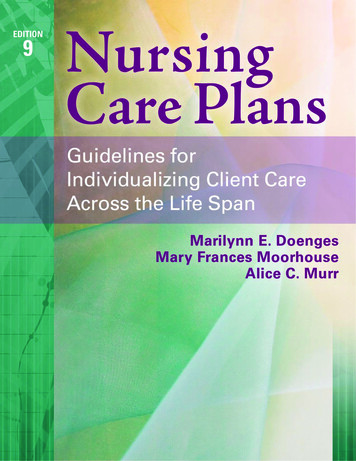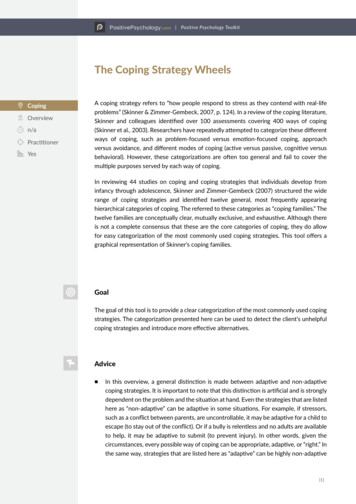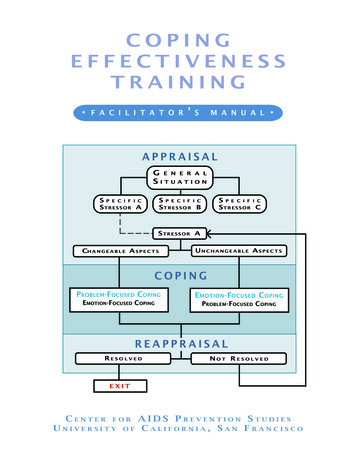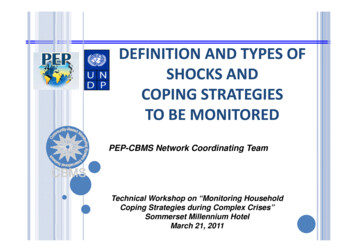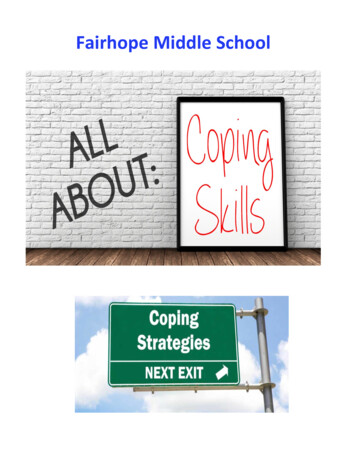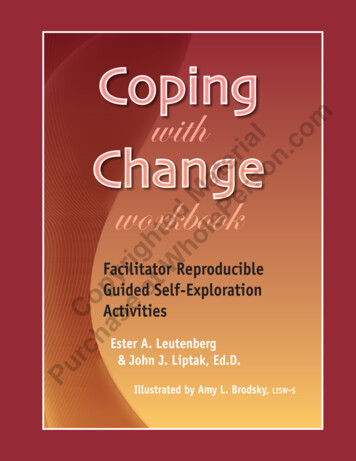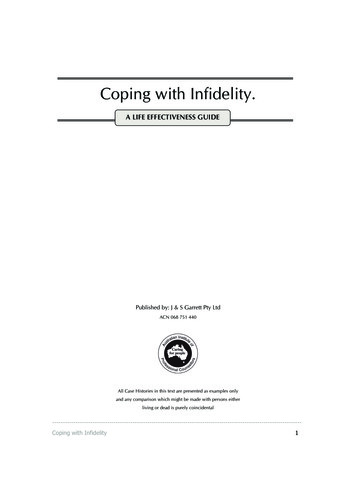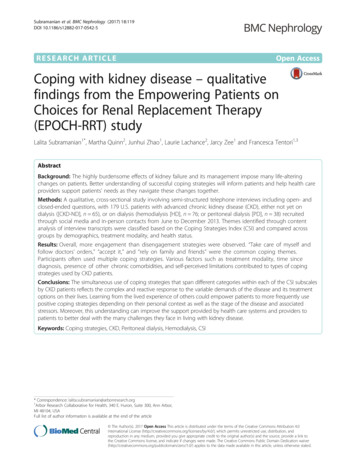
Transcription
VISTAS OnlineVISTAS Online is an innovative publication produced for the AmericanCounseling Association by Dr. Garry R. Walz and Dr. Jeanne C. Bleuerof Counseling Outfitters, LLC. Its purpose is to provide a means ofcapturing the ideas, information and experiences generated by theannual ACA Conference and selected ACA Division Conferences. Paperson a program or practice that has been validated through research orexperience may also be submitted. This digital collection of peer-reviewedarticles is authored by counselors, for counselors. VISTAS Online containsthe full text of over 500 proprietary counseling articles published from2004 to present.VISTAS articles and ACA Digests are located in the ACAOnline Library. To access the ACA Online Library, go tohttp://www.counseling.org/ and scroll down to the LIBRARYtab on the left of the homepage.nUnder the Start Your Search Now box, you may searchby author, title and key words.nThe ACA Online Library is a member’s only benefit.You can join today via the web: counseling.org and viathe phone: 800-347-6647 x222.Vistas is commissioned by and is property of the American CounselingAssociation, 5999 Stevenson Avenue, Alexandria,VA 22304. No part of Vistas may be reproduced without expresspermission of the American Counseling Association.All rights reserved.Join ACA at: http://www.counseling.org/
Suggested APA style reference:Slate, C. N., & Scott, D. A. (2009, March). A discussion of coping methods and counseling techniques for children and adults dealingwith grief and bereavement. Paper based on a program presented at the American Counseling Association Annual Conference andExposition, Charlotte, NC.A Discussion of Coping Methods and Counseling Techniques forChildren and Adults Dealing With Grief and BereavementPaper based on a program presented at the 2009 American Counseling Association Annual Conference andExposition, March 19-23, Charlotte, North Carolina.Candice N. Slate and David A. ScottSlate, Candice N. is currently a M.Ed. candidate in the Community Counseling Program at ClemsonUniversity. Her area of interest is grief and bereavement across the lifespan; particularly on techniques andskills most effective and well-received for those clients.Scott, David A. is currently the Community Counseling Program Coordinator and Assistant Professor atClemson University. His areas of interest include career and community counseling, identity development,and at-risk youth.The BasicsWhat Do Grief and Bereavement Really Mean?Most can agree with the simplistic definition provided by Webster that grief is “akeen mental suffering or distress over affliction or loss; sharp sorrow; painful regret”(Pickett, et al., 2005, p. 500). As we can see, grief is not too abstract a term for us todefine, because to some degree we have all experienced grief or seen it displayed inothers. Though it is not a hard term to wrap meaning around, it is however a complexentity in itself. It is presented differently in everyone through variances in intensity,complexity, duration, and the properties and stages that one experiences.Webster also defines bereavement as the “state of sorrow over the death ordeparture of a loved one” (Pickett, et al., 2005, p. 106). This term also seems prettysimple and equates to the reactions one goes through after losing a loved one. Again, theterms may be simple, but the emotions attached to both are very complex.Now that there is an established common understanding of the terms, one mightraise the question, is there a difference between grief and bereavement? Yes. Mostexperts offer an explanation similar to the following: bereavement is a term specificallyused to describe the effects experienced from the death of a significant other, whereasgrief can describe any sort of loss not necessarily related to death, i.e.: loss of control,loss of money, divorce (National Institute for Trauma and Loss in Children, n.d.).Stages of GriefIn 1969, Elisabeth Kubler-Ross (Kubler-Ross and Hobbing, 1997) published amodel to explain the stages of grief. This model is not specific to bereavement or thedeath of someone; this model is used for grief associated with trauma and change. In thematter of grief associated with death, this model can be applied to anticipatory grief
experienced by one who is facing their own death or to the loved ones who are preparingfor the death of a significant one in addition to the bereavement experienced followingthe death of someone. She denotes that there are five stages (denial, anger, bargaining,depression and acceptance) and that the bereaved may not go through all five stages, norfollow the steps in sequence, and that one may experience a stage more than once. Shedoes express that most individuals will experience at least two of the stages. The stagesare not linear nor are they equal in the time one spends per stage. A person does not haveto complete a stage in order to progress into another stage.Goals of Grief Counseling & Grief TherapyThere is a difference in the goals of grief counseling and grief therapy. The termgrief counseling is most often reserved for helping someone work through the process ofgrief via one-on-one counseling or through group work (Worden, 1991). The goals ofgrief counseling are to aide the individual through uncomplicated, normal grief to ahealthy resolution of the tasks of grieving within a reasonable amount of time.Goals of grief counseling typically include helping the bereaved move towardacceptance through guiding the individual to talk about the loss, who the person was tothem, and the circumstances surrounding the death. In addition, it is important to help thebereaved label and describe their feelings and emotions encompassing the loss. Anotherimportant goal of grief counseling is to help the individual learn coping strategies fortough times, such as anniversaries, holidays, birthdays, and milestones. Letting thebereaved know that the emotions they are feeling are normal and expected is also asignificant component of grief counseling. Two very critical constituents of griefcounseling include helping the bereaved to understand their coping behavior and toidentify coping mechanisms that are problematic or unhealthy for the individual.Without these basic principles, the person may continue these unhealthy patterns and mayneed more extensive treatment such as grief therapy.Grief therapy is a term used for more serious or complicated grief reactions thatusually fall under four main types including exaggerated grief, chronic grief, maskedgrief, and delayed grief (American Society of Clinical Oncology [ASCO], n.d.a).The main goal of grief therapy is to identify and resolve the conflicts of separationthat interfere with the completion of the tasks of mourning, such as the four complicatedgrief reactions mentioned above. Grief therapy entails talking about the loss anddetermining if there is minimal or exacerbated emotions surrounding the loss. Grieftherapy is intended to allow the bereaved to see that negative, uncomfortable feelings andemotions do not preclude more positive ones, and vice versa (Slate and Scott, 2009).Grief Across the LifespanGrief is unique for everyone, however there are some commonalities that can beshared within age groups. There are vast differences in the way that children and adultsgrieve, namely because children have not yet developed complex and abstract reasoningskills to express and understand their feelings and emotions.
Grief in ChildrenExploring how grief is presented in children can best be explained by dividing upthe developmental stages, as children attain abilities and refine them throughout theirgrowth.Infant- 3 years old.Children from birth through the age of three are not able to understand death.However, they are aware of the absence of a caregiver. This can be displayed by the childthrough symptoms such as an increase in crying, seeming more lethargic and listless, andvia noticeable changes in eating or sleeping habits (Fitzgerald, 1992). The child may alsolook about or seem to wait for the caregiver to return. A two or three year old mayassociate death with being asleep. Also, if a child sees a caregiver grieving or dwelling insadness, the child will often mimic those emotions though they do not understand them ornecessarily feel that way themselves (ASCO, n.d.b).Approaches/Techniques. Although children at this age do not understand death, itis still important, as counselors, to explain to the child what happened in order tohopefully alleviate thoughts that they may have about being abandoned by their lovedone. Using simple, but correct terminology is important. Saying “Grandma passed away”or “We lost him” is not helpful to the child for comprehension in the long run. A deathoccurring at this age for the child will be revisited as they arrive at further developmentalstages, so setting the pace now will lessen the confusion for them when they becomeinquisitive later about the death.3-6 year olds.This age group is very curious about death. They may ask questions like “Howdoes Mom breathe since he is dead?” because they are now able to understand that theperson is not there with them anymore but believe that they are alive in some limited kindof way. They may be able to recognize the physical death as temporary or gradual,reversible and not final. The child may also experience ‘magical thinking’, in which theybelieve that their thoughts caused the action (i.e., being mad at the parent, misbehaving,saying “I hate you”, etc.; ASCO, n.d.b). They are very much egocentric and may feel thatthey caused the death. Children at this age often temporarily regress with symptoms suchas bladder and bowel control, use baby talk, thumb sucking, want to sleep with a siblingor parent, and experience a change in eating and sleeping habits. They may also haveworries of abandonment and fear that when others leave that they are not going to comeback. Children at this age are also much more impressionable and are greatly influencedby the emotions that others are expressing, especially sadness.Approaches/Techniques. At this age it is especially important to be honest andprovide as much detail as can be comprehended by the child (Wolfelt, 1983). This shouldbe done to lessen the confusion and provide as much clarity about the event as possible.Doing so will help the child to understand that their thoughts and actions did notinfluence the death of their loved one. Measures should be taken to assure the child thatthey will be cared for and that one’s leaving does not preclude them from ever comingback. Counselors need to encourage the child’s guardians to try and keep to the child’s
regular routine and allow them to be their age. Children should be told what will takeplace at the memorial service and burial of the loved one and be given the option ofattending.Therapies that are especially helpful when working with grieving children includeplay, art, puppet, and storytelling. These therapies are beneficial because they allowexpression without words to show how they feel. It is easier for a child this age to drawor use a figurine to act out feelings than it is for them to indentify those same emotions ina verbal format. Counselors can gain much insight through watching and listening to achild partaking in these therapies. The use of creative expression in a therapeuticenvironment can help a child to express emotion and process their own grief (Glazer,1998).6- 12 year olds.Children at this age are typically able to understand the finality of death but donot view it as something that will happen to them until the latter part of thisdevelopmental stage. Children 10 and older seem to grasp the concept that they will dieand may dwell over the idea of their own death (ASCO, n.d.b). The younger part of thisage group may view death as a spirit, ghost, or angel. Boys often displace their grief asbeing aggressive and destructive whereas girls may become very clingy and attached.The range in emotions that are felt by this age group runs across a full gamut anywherefrom guilt, sadness, and anger to anxious, shameful, or worried. They often have troubleputting words to the emotions that they are feeling, so being cued into their actions ismost helpful. Some children will complain of physical ailments, like a stomachache,rather than being able to say that they feel afraid or sad.Approaches/Techniques. Yet again, the most important approach is to be honestand open when talking to the child about the death of their loved one. Letting the child bea part of the planning for the service also seems to be helpful in the closure process forthis age group (Slate and Scott, 2009). Techniques that would be beneficial to use withchildren of this age group include the use of sand trays, music, and recreation therapies inaddition to utilizing play and art therapy.Adolescents (13-18 years old).This age group has the same capacity of understanding grief as an adult does. Infact, this age group views themselves as adults, however they are caught somewhere rightin the middle developmentally. Pottmeyer and Scott (2008) contend that adolescents havetrouble stopping “the developmental clock” to deal with the death of a loved one. Griefcompounds and complicates the confusion that teenagers already face without anadditional trauma. Teenagers are not children but are not yet adults, and when they aregrieving the loss of a significant other they do not know which direction to take—theemotional dependence and sadness like a child, or the strong and brave approach of anadult. They will usually not reach out and embrace support from adults because thatwould make them appear childlike. Yet most will not seek solace in a peer for beingafraid of looking weak. Many times, this creates the idea in them that they must face italone and keep it together on the outside. The results of unresolved grief and
bereavement can lead to ongoing mental health problems ranging from depression, socialwithdrawal, substance abuse, defiant behaviors, and academic problems (Pottmeyer andScott, 2008). Caregivers and counselors for this age group can help by letting theteenager know that the confusion and emotional turbulence they are feeling is normal andthat it is okay to cry or express those undesirable emotions. Remind the adolescent thatthey are available and will help in appropriate ways. Be aware that grief at this agechallenges and contradicts the teenagers’ view of themselves as invincible and may createquestions and doubt in their religious views and understanding of the world (ASCO,n.d.b). Counseling techniques to use for this age group can include relaxation/yoga,cinema, music, expressive (drama and projective arts), and narrative (journaling, creativewriting, letter writing, poetry) therapy.Grief in AdultsIn an adult’s lifetime, one will likely experience grief in a number of differentrelationships, including, but not limited to, the loss of a parent, spouse, sibling, friend,family member, co-worker, or child. Many factors play into how an adult will grieveincluding what the nature of the relationship was with the deceased; grieving over theloss of a parent is likely much more intense than grieving over a neighbor. The cause ofdeath is often times a large component in the depth of one’s grief; typically an anticipateddeath offers more comfort versus a sudden, unexpected death. If the bereaved has noteffectively dealt with past losses, the grief process can be more complicated andmultifaceted when facing another loss. The personality and typical response to change isalso a component when an adult grieves; if one does not have a healthy reaction to loss oradjustment, they will not likely react in a healthful manner. One’s availability of supportfrom friends and family also strongly impact how one will grieve. Religion and spiritualbelief also plays an important role in the bereaved.An adult who is grieving will likely review their own life and appraise theiraccomplishments, shortcomings, goals, and their meaningfulness in the world. One mayalso envision their own death. If the adult is grieving over a spouse, parent, or child, theyare likely to experience many adjustments that influence grief; these may include achange in routine, responsibilities, priorities, relationships, goals, and activities.Grief in adults is displayed uniquely from one person to the next. Emotions andfeelings also run along a full scale and may vary in the individual over time. Many adultspreoccupy themselves to avoid their feelings while others become fixated on the loss andare unable to function for a period of time as they once did.Approaches/Techniques. One effective coping technique is to encourage abereaved adult to attend a support group with people who are experiencing a loss similarto their own. Journaling and relaxation techniques are often times very therapeutic for agrieving adult. Encouraging eating well and getting adequate sleep and exercise are alsoimportant. It is also significant to remind the bereaved to take time making majordecisions, such as moving, changing jobs, etc. Supporting the bereaved to find an outletfor comfort is beneficial through promoting one to review past hobbies or seek outactivities to help fill their time and renew their joy.
Grief in the ElderlyGrief in the elderly is slightly different than the grief that an adult experiencesbecause at this point in one’s life, many are more focused on dying than living. They areno longer looking forward to the future with anticipation of reaching milestones andgoals. Instead, this time in their life is one of reflection. Loneliness, at least to somedegree, is a central component in most elderly people, which intensifies exponentiallywhen they experience the loss of a loved one.Grief is presented in the elderly with an increased likelihood of having feelings ofsadness, loneliness, and depression. The elderly will tend to ruminate over their lossespecially if they have faced many losses in a short period of time (i.e., most of theirfriends or siblings have deceased).Approaches/Techniques. The approaches and techniques for this age group are thesame as those one would use with adults. One should also help the bereaved to secureadditional help in doing tasks that their loved one was able to do. Also, helping thebereaved to establish a caregiver or helping them to find community support services isof great importance since many in this population do not know what services areavailable for them to help with tasks that they may not be able to take care of themselves.Multicultural Component of GriefCulture plays an important and critical role in understanding the manner in whichone grieves. A person’s culture also aides in their concept of what happens to a loved oneafter death. One’s concept of the meaning of life and of death comes from one’s cultureand beliefs, so therefore the emotions and grief that one experiences is linked directly toone’s cultural identity (ASCO, n.d.c). Every culture has its own rituals and customs thatguide and shape the way the bereaved grieves.It is essential to note that there is not a standard for how someone should grieve.What is “normal” grieving to one may be considered inappropriate to another. There arehowever some specific questions to keep in mind when working with a grieving clientfrom a culture different than your own so that you can keep your perspective on what theclient believes (Slate and Scott, 2009). Asking what the client and family’s beliefsurrounding death is very important in knowing how to appropriately go through theirgrieving process. Also, learning what emotions and behaviors are considered normal griefreactions in their culture is key (ASCO, n.d.c). In addition, asking the bereaved whatspecial dates they know of that could be particularly difficult for them to face in thefuture is good to figure out so that you can help prepare them for those difficult timesappropriately.ConclusionGrief and bereavement are natural emotions that we all will experience. Simplyknowing the dictionary definition of grief and bereavement is not enough to effectivelyhelp clients. The key as counselors is to understand how grief and bereavement affectindividuals differently and take notice in the variation of comprehension and grief
presentation across different developmental groups. Knowledge of a client’s culturalbeliefs and practices continues to be an important construct. Proper training in griefcounseling techniques is critical to be an effective counselor in this field.
ReferencesAmerican Society of Clinical Oncology. (n.d.a). Help for when you are grieving.Retrieved September 10, 2008, from http://www.asco.org/patient/Coping/Grief and Bereavement/Help for When You Are GrievingAmerican Society of Clinical Oncology. (n.d.b). Helping a child or teenager who isgrieving. Retrieved September 10, 2008, from http://www.asco.org/patient/Coping/Grief and Bereavement/Helping Grieving Children and TeenagersAmerican Society of Clinical Oncology. (n.d.c). Understanding grief within a culturalcontext. Retrieved September 10, 2008, from http://www.asco.org/patient/Coping/Grief and Bereavement/Grief Among CulturesFitzgerald, H. (1992). The grieving child: A parent’s guide. New York: Fireside.Glazer, H. (1998). Expressions of children’s grief: A qualitative study. InternationalJournal of Play Therapy, 7, 51-65.Kubler-Ross, E., & Hobbing, E. (1997). On death and dying. New York: Simon &Schuster Adult Publishing Group.The National Institute for Trauma and Loss in Children (n.d.). Grief and trauma: Theconfusion – the difference. Retrieved September 10, 2008, fromhttp://www.tlcinst.orgPickett, J., et al. (Eds.). (2005). Webster’s II New College Dictionary (3rd ed.). Boston:Houghton MifflinPottmeyer, H. B., & Scott, D. A. (2008). Effects of bereavement and grief on adolescentdevelopment. Grief Digest, 5, (4), 24-25.Slate, C. N., & Scott, D. A. (2009). Relevant concepts and techniques for schoolcounselors working with children and adolescents dealing with grief andbereavement. New York State School Counseling Journal, 6, 44-52.Wolfet, A. (1983). Helping children cope with grief. Muncie, IN: AcceleratedDevelopment.Worden, J. (1991). Grief counseling and grief therapy. New York: Springer PublishingCompany.
grief, and delayed grief (American Society of Clinical Oncology [ASCO], n.d.a). The main goal of grief therapy is to identify and resolve the conflicts of separation that interfere with the completion of the tasks of mourning, such as the four complicated grief reactions mentioned above. Grief therapy entails talking about the loss and
